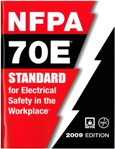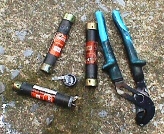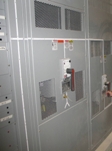
Qualified or Just Experienced?
OSHA is training its Field Safety Compliance Officers and its lawyers (uh-oh) on how to use the 70E to justify citations for unsafe work practices. That should send a shudder through any company's legal staff.
- By James R. White
- Jun 01, 2009
You're a Journeyman electrician, or maybe a Master. You've been in the trade for 15 years and know the NEC front to back. Co-workers constantly ask you questions on the proper method to install electrical circuits and components. Here's a blast for you: You're probably not qualified! At this point, many reading this are saying to themselves, "This guy is full of ____ !" You fill in the blank. It wouldn't be the first time I've heard that, and it probably won't be the last. But that's beside the point. Being qualified in OSHA's sight is more than knowing how to do your job; that is, the technical or skills side of your job. You also must receive training on how to do your job safely, and OSHA is very specific about what that takes.
Many people are aware that in August 2007, OSHA passed a new Subpart S 29 CFR 1910.303 to .308. This section was adopted from chapter 4 of the 2000 edition of the NFPA 70E, Standard for Electrical Safety in the Workplace. People who are generally aware of those changes may be unaware that 29 CFR 1910.399, Definitions Applicable to this Subpart, also contained changes. The biggest change in .399 was the definition of a qualified worker. The old definition was, "Qualified person -- One familiar with the construction and operation of the equipment and the hazards involved." The new definition states, "Qualified person. One who has received training in and has demonstrated skills and knowledge in the construction and operation of electric equipment and installations and the hazards involved." Minor wording changes? I don't think so.
This definition has three parts: 1) training in the skill required, 2) demonstrating those skills, and 3) knowledge of the construction and operation of electric equipment and installations and the hazards involved. Some companies are taking the approach that CBT (computer-based training) or video-based training is adequate for training their qualified electrical workers. No, no, no! OSHA, in a Letter of Interpretation dated Nov. 22, 1994, says, "In OSHA's view, self-paced, interactive computer-based training can serve as a valuable training tool in the context of an overall training program. However, use of computer-based training by itself would not be sufficient to meet the intent of OSHA's training requirements . . . ."
Training Essentials
What many Journeyman and Master electricians lack is the OSHA-mandated safety training. Qualified electrical worker safety training needs to include such items as electrical hazard awareness, the applicable OSHA regulations (29 CFR 1910.331 through .335, .137, .147, .133, and .132, to name a few), use of PPE and equipment, conducting a Hazard/Risk Analysis, and the NFPA 70E. That's right, the NFPA 70E. OSHA is training its Field Safety Compliance Officers and its lawyers (uh-oh) on how to use the 70E to justify citations for unsafe work practices. That should send a shudder through any company's legal staff. So what does qualified require?
Being aware of electrical hazards. If you don't recognize a hazard, you can't avoid the hazard. Several years ago, I was in Petersburg, Va. doing a training class for a customer, and on the front page of the local newspaper was an article about a painter. He had constructed a scaffold to paint a commercial building, climbed up, and proceeded to roll out the paint. He made contact with the drip loop coming into the building with his aluminum extension pole and was electrocuted. He saw the conductors were covered but didn't recognize the hazard. Result: dead.
OSHA regulations. Both the worker and their supervisors--especially supervisors who have electrical workers on their shift, even though the shift supervisor is not an electrical supervisor--are required to have training in the OSHA regulations and must understand them. Not only do qualified electrical workers require this training, but also their supervisors need the same training so they understand the problems and issues faced by working on or near exposed, energized electrical conductors and parts. As an example, here's what used to happen to me on swing or midnight shifts: We were supervised by an operating engineer foreman, and if we didn't think something was safe and brought it to their attention, we were told, "If you want to be here tomorrow, you'll get this done today." They had no understanding of the issues and hazards involved with electrical work.
 Let's not forget workers that OSHA would consider unqualified. They also need some level of safety training.
Let's not forget workers that OSHA would consider unqualified. They also need some level of safety training.
Painters, janitors, helpers, apprentices, and any other worker who may come in contact with equipment that could be exposed and energized will require electrical safety training.
Mostly, this training consists of being made aware of the hazards and how to avoid them (where not to put your fingers or that aluminum paint roller extension, for example).
Use of PPE and equipment. "Use of" does not mean just the mechanics of how to use it. It also means training on:
- The selection of proper tools, PPE, and insulating and shielding materials required. Are they appropriate for the voltage and the conditions of use, and do they meet ASTM and NFPA 70E standards? Is it the right tool for the job? For example, Channel Locks® are not fuse pullers! I know, I know, they just look so right for the job! In the above figure, note the outline of the worker's hands on the handles. Sweeeet!
- The proper method to inspect these items and ensure they are safe to use. Do you know how to inspect PPE for damage? Do you know what can affect its ability to protect you, such as cuts, rips, or holes in the material or grease spots for arc flash PPE, or corona cutting and punctures in rubber insulating gloves?
- Are the PPE and equipment appropriate for the tasks? Does the label state that it meets ASTM F1506 and NFPA 70E? In the 2009 edition of NFPA 70E, we added a requirement that arc flash clothing and equipment be "arc rated." It must be designed and rated specifically for electrical workers, not steel workers and not firemen (no offense to those workers intended). The heat from an arc flash is very intense, but also of a very short duration. Our needs are different from these other workers.
- How are the PPE and equipment used properly? Is the PPE being worn properly? Are there gaps that could allow the heat of an electrical arc to pass through? Is the arc-rated PPE correctly sized? Usually, clothing is to fit snugly so it won't get caught in machinery, but that's not true for arc-rated PPE. It has to fit loosely. If you look like sausage boy in your arc flash coveralls, the heat from an arc flash could be transferred right through the clothing, and you'll receive a severe burn.
Conducting a Hazard/Risk Analysis.
 Most electrical workers have no idea how to assess the hazard, much less how to assess the risk associated with the task. Both are critical for worker safety. Evaluating the voltage hazard is fairly straightforward. The nominal voltage (system design voltage) determines the glove class. Evaluating the arc flash hazard is simple if the system has had an arc flash study performed on it. The arc flash protection boundary and incident energy at working distance will be listed on the label. If no arc flash study has been done, Tables 130.7 in NFPA 70E can be used to choose PPE and equipment. Be certain to use the notes at the end of the tables, however, or the PPE you choose may be inadequate for the hazard.
Most electrical workers have no idea how to assess the hazard, much less how to assess the risk associated with the task. Both are critical for worker safety. Evaluating the voltage hazard is fairly straightforward. The nominal voltage (system design voltage) determines the glove class. Evaluating the arc flash hazard is simple if the system has had an arc flash study performed on it. The arc flash protection boundary and incident energy at working distance will be listed on the label. If no arc flash study has been done, Tables 130.7 in NFPA 70E can be used to choose PPE and equipment. Be certain to use the notes at the end of the tables, however, or the PPE you choose may be inadequate for the hazard.
Evaluating the risk is another story. The incident energy listed on the arc flash label or the arc-rated PPE and clothing specified in 70E are both based on these three things:
- Equipment that is properly designed and engineered
- Equipment that is properly installed in accordance with all applicable codes and standards
- Equipment that is properly maintained
If any one of these conditions is not met, the actual incident energy the worker could face is unknown. Maintenance is too easy to put off, either due to cost-cutting or lack of problems (probably the result of a good PM program). Incident energy is proportional to time. If the time of exposure is doubled, the incident energy received by a worker doubles. Improper maintenance of circuit breakers are one primary reason time of exposure could increase. If a circuit breaker should operate in no more than 4 cycles (0.0167 second/cycle) and it operates in 8 cycles (still less than 1/10th of a second), the arc rating of your PPE is going to be way under what it needs to be.
Other items that affect the risk associated with performing tasks are:
- Equipment condition
- Equipment age
- Equipment configuration. The above figure shows an older installation using expanded metal for cooling. When operating this equipment, you need more arc flash PPE because the arc plasma ball would come rolling right through those vents. The vents cannot be sealed or covered because the venting is needed to provide cooling. In this situation, special training and/or labeling warning workers of the additional hazards posed would be recommended.
- Environment
- Loading
- Maintenance (or lack of)
- Equipment operating history
- Any other factor that may contribute to misoperation
Once a Hazard/Risk Evaluation is performed, you often find that more arc flash protection is needed, not less. If there is any doubt about whether the OCPD (overcurrent protective device) protecting the circuit or device about to be worked will function properly, the next upstream OCPD has to be used. This may mean going upstream to the utility OCPD if the facility is deemed unreliable. Your best bet: turn it off!
NFPA 70E
OSHA tells us what to do in broad, regulatory, non-prescriptive language. (Sounds like the definition of vague, to me.) NFPA 70E, however, is very specific (prescriptive) about what to wear and what safe work practices are required when performing energized work. 70E and the OSHA regulations work hand in hand; OSHA gives us the broad-brush stroke, while 70E provides the details. OSHA says 70E is "a guide for meeting the regulations," and federal courts have found 70E to be "standard industry practice." 70E is truly a required reference for all electrical workers and supervisors of electrical workers.
In its revision to the definition of a qualified electrical worker, OSHA included two other important concepts:
- The worker must demonstrate proficiency in the work practice.
- The worker must understand the construction and operation of the equipment, but of the electrical installation, as well.
Demonstrating proficiency means they must show they can do the job safely and effectively. Key item: Document this training. If you don't document, you can't prove you did it. Training on the installation (system) is critical when isolating or switching electrical equipment or devices. If a worker does not understand how a system functions and its hazards, he could create a dangerous situation not only for himself, but also for other workers. There are different hazards associated with Loop systems, Main-Tie-Main systems, Breaker-and-a-Half systems, etc. Misunderstanding or not knowing the issues involved is extremely dangerous.
Summary
Being a qualified electrical worker is not easy. Looking at the above requirements, as well as those given in 29 CFR 1910.332 and .333, it takes more than just a half-hearted effort to be qualified. Training records are one of the first things OSHA looks at during an audit. If you're doing OJT (On-the-Job) training, be sure to document that, as well. If you don't document it, you can't prove you do it.
Training also has to include demonstrating the skills needed (again, refer to 29 CFR 1910.332 and .333), so make sure the training you conduct or contract for includes written lab sessions as part of the curricula. Also, make sure the training covers how the system operates. Loop, radial, Main-Tie-Main, double-ended subs, etc. all present unique operational hazards for personnel who are not familiar with them.